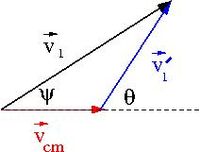Difference between revisions of "Forest UCM MiNF"
Jump to navigation
Jump to search
| Line 33: | Line 33: | ||
where | where | ||
| − | : <math>\vec {F}_{\mbox {inertial}} = m \vec A \equiv</math> inertial force | + | : <math>\vec {F}_{\mbox {inertial}} = m \vec A \equiv</math> inertial force |
| + | |||
| + | The inertial force may also be referred to as a fictional force | ||
| + | |||
| + | an example is the "fictional" centrifugal force for rotational acceleration. | ||
| + | |||
| + | The observer in a noninertial reference frame will feel these frictional forces as if they are real but they are really a consequence of your accelerating reference frame | ||
| + | |||
| + | example | ||
| + | :A force pushes you back into your seat when your Jet airplane takes off | ||
| + | :you slam on the brakes and hit your head on the car's dashboard | ||
| + | |||
| + | |||
[[Forest_Ugrad_ClassicalMechanics]] | [[Forest_Ugrad_ClassicalMechanics]] | ||
Revision as of 13:31, 3 November 2014
Mechanics in Noninertial Reference Frames
Linearly accelerating reference frames
Let represent an inertial reference frame and \mathcal S represent an noninertial reference frame with acceleration relative to .
Ball thrown straight up
Consider the motion of a ball thrown straight up as viewed from .
Using a Galilean transformation (not a relativistic Lorentz transformation)
At some instant in time the velocities add like
where
- = velocity of moving frame with respect to at some instant in time
taking derivative with respect to time
where
- inertial force
The inertial force may also be referred to as a fictional force
an example is the "fictional" centrifugal force for rotational acceleration.
The observer in a noninertial reference frame will feel these frictional forces as if they are real but they are really a consequence of your accelerating reference frame
example
- A force pushes you back into your seat when your Jet airplane takes off
- you slam on the brakes and hit your head on the car's dashboard
